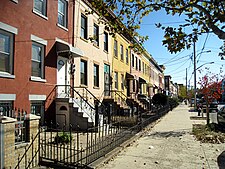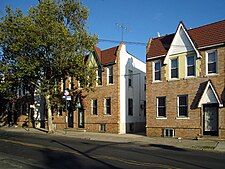
Wyckoff Heights is an area within the New York City boroughs of Brooklyn and Queens, straddling the border between Bushwick, Brooklyn, and southwest Ridgewood, Queens. Wyckoff Heights was urbanized starting in the late 19th century, and took its name from the Wyckoff family, who owned the land. The area was home first to many German immigrants, later followed by Italian and more recently Latino and Eastern-European residents.
Wyckoff Heights is located largely within ZIP Codes 11237 and 11385. Points of interest include Wyckoff Heights Medical Center and the former Wyckoff Heights Presbyterian Church.
History

Wyckoff Heights was urbanized starting in the late 19th century, and took its name from the Wyckoff family who owned and farmed much of the land. Development progressed from Brooklyn into Queens as portions of the Wyckoff farm were sold. In 1890, newspapers announced the creation of a new park (now Maria Hernandez Park) to be located in Wyckoff Heights, within the 18th Ward of Brooklyn. In 1892, Queens County property owners established the Wyckoff Heights Improvement Association to lobby for water, sewer, and gas service to the neighborhood, and the next year, the Wyckoff Heights Water Company was formed to supply drinking water to the area. In 1901 residents of the Queens section lobbied the City government to "adopt a system of house numbering" and erect street signs so that the postal service would begin delivery to the neighborhood. The last 18 acres (73,000 m) of farmland were developed in the 1940s.
ZIP Codes
Initially, mail delivery to the Queens section was provided by the Brooklyn Post Office. The Wyckoff Heights Post Office (ZIP Code 11237) at 86 Wyckoff Avenue was opened in 1951, serving north Bushwick and the Brooklyn portion of Wyckoff Heights. When ZIP Codes were assigned in 1963, all areas whose mail was routed through a Brooklyn post office were given the 112 prefix. The neighboring areas of Glendale and Ridgewood in Queens were given a Brooklyn mailing address, 11227, shared with Bushwick and Wyckoff Heights. In addition, parts of Bushwick and Wyckoff Heights were in ZIP Code 11237. After the 1977 New York City blackout, newspapers around the country published UPI and Associated Press' photos of Bushwick residents with stolen items and a police officer beating a suspected looter, and Bushwick became known for riots and looting. After the 1977 blackout, the communities of Ridgewood and Glendale expressed a desire to disassociate themselves from Bushwick.
Following complaints from residents, Postmaster General William Bolger proposed that the ZIP Codes would be changed if United States Representative Geraldine Ferraro could produce evidence that 70% of residents supported it. After Ferraro's office distributed ballots to residents, 93 percent of the returned ballots voted for the change. The change of the Queens side to ZIP Code 11385 was made effective January 13, 1980. 11237 was reassigned to cover only Bushwick and Wyckoff Heights, and 11227 was eliminated.
Land use
Residential

The first buildings constructed in the neighborhood were largely attached wood frame three- and six-family row houses.
Around the turn of the century, as urbanization moved northeast towards the borough line and into Queens, developers switched to masonry construction in order to conform to new building and fire codes. Many of these buildings are now part of the Cypress Avenue West Historic District.
In the 1940s the last large-scale development in the neighborhood saw the construction of more automobile-oriented attached single-family homes with alleys and garages in the rear.
Points of interest
Wyckoff Heights is home to the Wyckoff Heights Medical Center at Wyckoff Avenue and Stockholm Street (originally the German Hospital of Brooklyn, renamed in 1918), and the former Wyckoff Heights Presbyterian Church at Harman Street and St. Nicholas Avenue (founded in 1895 and rebuilt after a 1928 fire, now the Ridgewood Pentecostal Church).
References

- "Proclamation Letter" (PDF). New York City Department of Education. p. 1. Retrieved October 23, 2011.
- "I OLD PHILANTHROPIST DEAD.; Peter Wyckoff Was Millionaire Farmer and Banker of Bushwick". The New York Times. February 10, 1910. ISSN 0362-4331. Retrieved February 1, 2020.
- Ambruster, Eugene L. (1912). The Eastern District of Brooklyn. pp. 125–126.
- "The Biggest Mouth in New-York.; Something About Its Owner and His Interesting Family". The New York Times. October 30, 1890. ISSN 0362-4331. Retrieved February 1, 2020.
- "Selecting Another New Park, To Be Situated Upon Wyckoff Heights". New-York Tribune. October 30, 1890 – via ProQuest.
- "They Want Sewer Connection: Wyckoff Heights Improvement Association Takes Action". Brooklyn Daily Eagle. January 21, 1892. p. 1. Retrieved February 1, 2020 – via Brooklyn Public Library; newspapers.com
 .
.
- "Proceeds of the Board of Aldermen of the Municipal Assembly of the City of New York". City of New York. 1901. p. 671.
- "Builders Acquire Old Queens Farm; $2,000,000 Home Community Is Planned for Final 18 Acres of Wyckoff Holdings". The New York Times. October 14, 1945. ISSN 0362-4331. Retrieved February 1, 2020.
- "Free Delivery Extensions - Mail Carriers for East Williamsburgh, Union Course and Wyckoff Heights". Brooklyn Daily Eagle. August 30, 1900. p. 14. Retrieved February 1, 2020 – via Brooklyn Public Library; newspapers.com
 .
.
- "New Postal Station in Brooklyn". The New York Times. June 17, 1951. ISSN 0362-4331. Retrieved February 1, 2020.
- ^ Rainie, Harrison (February 21, 1979). "Zip-zero to Queensites". New York Daily News. p. 580. Retrieved February 1, 2020 – via newspapers.com
 .
.
- ^ "ZIP Codes and Politics: How Redrawing Borough Lines Redefined Bushwick and Ridgewood". Bushwick Daily. September 6, 2017. Retrieved January 1, 2020.
- Examples:
"Policeman Discourages a Looting Suspect in the Bushwick Section of Brooklyn" (photo). United Press International. Philadelphia Daily News. July 15, 1977. – via newspapers.com
"Police Collars Looter in Bushwick Section of Brooklyn" (photo). UPI Telephoto. Florida Today (Cocoa, Florida). July 15, 1977. – via newspapers.com
"His Share of Booty" (photo). Associated Press. Muncie Evening Press (Muncie, Indiana). July 15, 1977. – via newspapers.com
- Lee, Jennifer 8. (November 2, 2007). "Is Ridgewood the New East Bushwick?". The New York Times. Retrieved August 21, 2009. ISSN 0362-4331.
- Rabin, Bernard (February 21, 1979). "Zip, Zip, Queensite Please Pick Your Zip". New York Daily News. p. 580. Retrieved February 1, 2020 – via newspapers.com
 .
.
- Rabin, Bernard (May 31, 1979). "Zip Code Vote Overwhelmingly for Queens". New York Daily News. p. 615. Retrieved February 1, 2020 – via newspapers.com
 .
.
- Rabin, Bernard (October 3, 1979). "Two Communities Will Receive New Zip Code Numbers". New York Daily News. p. 622. Retrieved February 1, 2020 – via newspapers.com
 .
.
- Donald G. Presa (August 1983). "National Register of Historic Places Registration: Cypress Avenue West Historic District". New York State Office of Parks, Recreation and Historic Preservation. Archived from the original on October 19, 2012. Retrieved February 1, 2011. See also: "Accompanying 10 photos". Archived from the original on October 19, 2012. Retrieved February 1, 2020.
- "Chapel on Wyckoff Heights". Brooklyn Daily Eagle. October 27, 1895. p. 20. Retrieved February 1, 2020 – via Brooklyn Public Library; newspapers.com
 .
.
- "Brooklyn Church Burns". New York Evening Post. January 3, 1928. p. 16.
External links
- Fernandez, Manny (December 10, 2010). "Of Queens and Kings". The New York Times.
40°42′11″N 73°55′08″W / 40.703°N 73.919°W / 40.703; -73.919
Categories:
